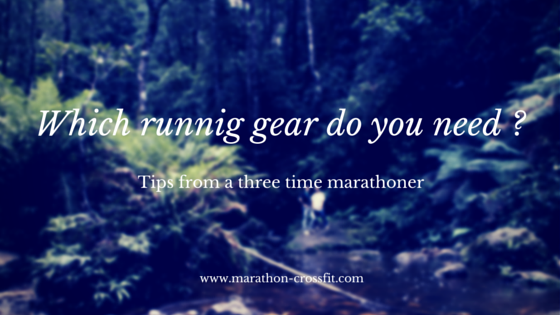Which running gear do you need ?
I personally run for 2.5 years now and finished the Dublin, Frankfurt and Vienna marathons as a hobbyist with a full time job. As there is a lot you can buy, once you get in the world of running, here are some tips, what you really need and what stuff is just a nice to have. If you have any specific questions, feel free to ask.
General points on running gear
When buying sports equipment functionality always goes over design. Even though you might think this is straight forward I’ve done this mistake not just once but several times. Each time I bought sports equipment and did not watch out for my sports goals I lived to regret it. Bright colors are generally recommended for running gear to make you more visible. Everything should fit tightly on you and be light. Fabrics which let air and sweat through are preferred, but normal T shirts will do just fine.
Another good approach is to think in layers. You want the least amount of layers possible while still keeping warm. An advanced runner will also want to prepare himself for all the seasons and might need several sets of clothing depending on how warm or cold it is.
Shoes should provide stability and cushioning to your foot. How much is needed depends highly on the individual.
Gloves do help in winter. I personally recommend mountain biking or biking gloves. The usual thinsulate glove for ten euros around the corner is usually to hot and keeps in all the sweat. They also start to smell quickly in a small wardrobe.
You do not need a lot of gadgets. Pick one that fits your style the most. The pouches for smartphones work remarkably well, so you might not even not to buy one. I got one for five bucks out of the local sports world and run several times in severe rain. No harm done to my phone.
If you are a beginner you will most likely not need to buy anything
You will find many definitions of a running beginner on the internet, depending on which website you will look at. I personally would say beginner level is somewhere in between one to two runs a week up to half an hour each.
You want to run to stay healthy and enjoy yourself while running, maybe with a friend or in a group. Chatting about everyday life, the kids, your partner, you might even bring your dog along. Your doctor might have advised you to get more active to get your stress levels down. Any of these scenarios you can think of.
If you are that kind of person I think you do not really not a lot of gear to get started and do your thing. A common rain jacket, a pair of regular runners from the local store, old t shirts and long trousers depending on the climate will do you just fine. You should roughly spend 20€ on the trousers, 10 – 20€ on a shirt here and there and use one of your old silly hats when it is cold. Nothing to get excited about.
Most likely you will also only be in need for summer gear, as you will not run in winter or in the gym only.
With beginners I think the bigger challenge is that they out running or any other exercise on the long finger using the gear as an excuse. I wanted to start running for a long time, I even had the expensive pair of shoes ready, but always said that I did not have the right trousers. One day my girlfriend got fed up with it and dragged me to Elverys to get some Slazenger “luxury leg covers” for 20 bucks and that she started something that she would live to regret (gearwise).
If you are intermediate get more sets to keep clean and proper rain gear
Once you get to the stage that you run 3 – 5 times a week with occasional runs lasting longer than half an hour I would personally say it is time to upgrade.
Get some proper running shoes for 80+ euros and let someone do an assessment. The heavier you are the more likely it will be that you need cushioning in the shoe. Also have 5 – 6 sets of running gear to rotate with the washing to have always one set ready to go.
If you are an outside runner and want to go all year round I recommend skins for the winter to wear under your shorts as they are much more comfortable as long “joggers”. You’ll also want gloves, a head and some kind of reflector to keep you safe, as you will run when it is dark or getting dark.
To avoid blisters have some tennis socks to avoid those which are snug on your feet. Another piece of equipment to have in the shower is a nice massage brush to do some maintenance for your muscles after a run.
If you only run for fun you will not need any technology to track your progress, but if you want to do the 5k run here and there or a half marathon once in a while start out with getting the Nike+ running app for free on your smartphone. These will also give you the opportunity to follow a running program to enhance your performance.
If you are advanced get a garmin watch and the necessary food and medication
I personally would classify you as advanced if you run 4+ times a week and understand the differences between an Interval run, Pace run, Easy run, long run and a threshold run. You want to compete and you want to improve. You are not only in it to stay healthy, but also to chase a personal best.
You have heard of the concept of a VO2 max and know how to use it.
Usually you will already have the gear that an intermediate runner has. The things to consider here might be a nutrition belt and a bottle to stay hydrated for long runs, although I personally have neither of those.
Definitely get a Garmin watch to track your progress. I found the GPS of the Nike+ app to be insufficient a lot of times and also the battery of your smart phone will usually run out after 1.5 to 2 hours. That is definitely something you do not want to happen on your long run. This is not crucial when you do not incorporate long runs or intervals in your training, but once you do you will get annoyed with the limitations of Nike+ pretty fast.
Once you run more and you do not any strength training your risk of injury goes up. Therefore the main differences in gear between the intermediate and advanced runner do not lay in running gear itself, but in the things he or she keeps at home to prevent injury and do proper maintenance once an injury occurs.
Have a sports ice pack in the fridge to use for RICE and also keep a foam roller to get rid off the lactic acid in your muscles. Fish Oil will provide the necessary Vitamin D to ensure good recovery and minimize flu risk. Hot water bottles in the winter after a cold run do wonders. Blister plasters, Vaseline and baby powder help you to prepare for races and keep rashes away.
For race preparation keep a bin bag to pull over your head, once you have handed in clothes bag to the race crew, to keep you warm until the start of the race or have an old jumper you can just toss away a few minutes before you are allowed to roam free.
One further upgrade I did was to a very snug rain jacket (in my case an FJ golfing jacket which I love). Once you run on an almost daily basis the wind which is caught by average rain jackets can get rather annoying. A good, snug rain jacket which is used for mountaineering, sailing or running will help for this instance.
High socks can help you to keep the lactic acid out of your thighs for a longer term preventing failure in long distance running. I haven’t seen a lot of the professionals with those on the course though.
Conclusion
You will only need 60 – 100€ to start running or you most likely even have everything at home. Do not wait, it is a great way to strengthen your immune system by getting more vitamin D, get more oxygen, train your cardiovascular system and be active. You can save yourself a lot of money when you compare it to a gym membership and will also help you to be more disciplined. For me it was the beginning of a new era of my life which lead to a new job, a happier life and journeys around Europe. Start with a 5k and slowly progress towards longer races.
Further reading
- Skins A400 two year review
- Best lifting belt for all
purposes review [Article, Video] - Precise Adidas Powerlift 2.0:
1 year review [Article, video] - Wrist wraps for powerlifting review
- Crossfit Equipment: Monolift Station
- How to train your lungs for
crossfit and marathons - Best knee sleeves from Rehband review
- Best gym shorts review
- Crossfit Equipment: Review of the Rogue Pylo Jump Box
- Which shoes should
crossfitters buy ? - Crossfit Equipment: Gloves
- Crossfit equipment: Dip Belt vs Vest
- Crossfit equipment: Jump rope
- Crossfit Equipment: Running shoes
- Crossfit equipment: Wooden rings


